Bihar government in its economic survey conducted earlier this year in February revealed that state has registered an average 10 per cent growth higher than the whole country. According to the survey, the main growth drivers that contributed in the economy of Bihar were air transport (36 per cent), other services (20 per cent), trade and repair services (17.6 per cent), road transport (14.0 per cent), and financial services (13.8 per cent).
Being an agrarian economy, animal husbandry contributed to the fair amount of this growth. Survey stated that egg production surged in the state from 111.17 crore in 2016-17 to 176.34 crore in 2018-19. Along with this, total fish production rose up from 4.79 lakh tonnes in 2013-14 to 6.02 lakh tonnes in 2018-19. The annual growth rate of operational agro-based factories during last ten years in Bihar was noted as 16.4 per cent as compared to India’s meagre 3.3 per cent.
Talking about economic condition of Bihar, Arun Singh, Global Chief Economist, Dun & Bradstreet says, “Bihar has clocked an average growth rate of almost 10 per cent for two years indicating its steady stride towards achieving its developmental goals. It contributes to only 3 per cent of India’s GDP being an agrarian state largely with a huge population base, but it is striving towards industrial development.”
He adds, “Of the 187 reform points under the Business Reform Action Plan 2018-19, Bihar implemented 153 and ranked 26th out of 36 states in the Ease of Doing Business Index for states. This is likely to support the large section of MSMEs based within the state. The enhanced thrust on MSMEs by the Central Government is expected to support the industrial drive in the state.”
An unprecedented slump in economic growth
Though this brief analysis based on survey indicates that the state is gradually strengthening its industrial clusters. But, Bihar has the lowest per capita income among other states in India and it lags behind by 33.1 per cent till today. However, there is some hike in amount from Rs 21,750 in 2011-12 to Rs 30,617 in 2018-19, but it is miniscule.
Speaking with SME Futures, Professor Pavnesh Kumar, Dean at School of Commerce and Management Sciences at Mahatma Gandhi Central University tells us that there are several reasons behind the lag of Bihar in per capita income. He tells that Bihar lacks land reforms, which leads to uneven land distribution. Thus, the ownership of land is concentrated in few hands and majority of the populace is landless there.
The second reason behind this slump is low land productivity due to less intervention of technological and scientific methods in agriculture and lack of commercial farming. Along with this, majority of manufacturing units which generate employment are shut down as major industrial towns are now a part of Jharkhand. Lastly, due to lack of opportunities and adequate physical and social infrastructure, there is brain drain in Bihar. North Bihar is mostly flood affected during monsoons and sizeable part of South Bihar suffers from drought, he tells us.
Deterioration of rural economy due to pandemic
The coronavirus pandemic and lockdown has created a new set of challenges for economy of the state. Considered as most economically backward among all states, Bihar has faced large-scale disruption of economic activities as the production units were shut. This further led to the extinction of small-scale cottage industries.
This implies a permanent loss of the productive capacity of the Bihar economy, states Asian Development Research Institute (ADRI), which worked extensively on the economic survey. According to the institution, Bihar economy is likely to contract by 15 to 18 per cent.
“In the case of Bihar, the public investment accounts for a major part of the total investment and this component will decrease substantially in 2020-21, as state finances will be much stressed due to the crisis. The resulting negative overall growth rate of Bihar economy under reasonable assumptions will be approximately between minus 15.0 to 18.2 per cent,” revealed the report.
The report further states, “The negative impact of COVID-19 on Bihar economy may be relatively less than India as a whole (23.9 per cent in the first quarter of FY 2020-21), but in absolute terms, the impact is substantial. Therefore, the state government needs to adopt several strategies to overcome the challenges.”
Rise of unemployment due to massively hit informal workforce
The lockdown imposed after the outbreak of pandemic affected the informal workforce of Bihar massively. This is approximately 94 per cent of the total workforce in Bihar. Also, a huge influx of migrants during the initial phase of lockdown added to the woes. This has led to another major wave of unemployment in the state.
In past few months, Bihar was among the worst affected states in terms of unemployment during the lockdown. While the all-India unemployment rate during peak months was 24 per cent, it almost doubled the national average i.e 46 per cent during that period for Bihar, indicates Centre for Monitoring Indian Economy (CMIE).
As unemployment rate is still on the rise, the challenge has become a centre-stage for Bihar elections. As per CMIE data, India’s unemployment rate is 6.8 per cent while Bihar stands at 9.8 per cent which is relatively high when compared. Mahesh Vyas, Managing Director and CEO of CMIE state that unemployment has been rising in Bihar steadily. More importantly, the situation is turning worse since 2018.
In 2016 and in 2017, the unemployment rate in Bihar was lower than the all-India average. Since 2018, it has been consistently higher. Further, the gap between the two has been widening since then. This could explain the high influence of unemployment in these elections. Lack of jobs is relatively higher in rural regions than in urban regions. Even the remuneration of daily wages is lesser than an all-India average. A construction worker on daily wage gets Rs 302 per day while the national average of it in other states is Rs 340.
Challenges in the revival of local economy
The state does not have major fund access due to lack of industries and is primarily dependent on government funds. In such circumstances, responsibility for reviving sectors rests majorly on the shoulder of state government. This has been further explained in the ADRI report. It states that Bihar has been heavily dependent on central transfers and grants for resources, which was 77.6 per cent in the year 2018-19.
This significant reduction in the revenue collection of the central government will affect the state finances badly. Hence, Bihar needs to explore the possibility to generate more revenue from its own sources. It was noted that growth of the state depends heavily on increasing fiscal capacity of the state government. This indicates that the state government and sectors have a bigger role in reviving the economy.
On the other hand, the crisis gives an opportunity to revisit the functioning of lower-level bureaucracy for efficient implementation of the government policies. First of all, the government has to work on increasing purchasing power and have to provide employment. Here, MGNREGA, a demand-based employment programme can be an effective short-term relief measure for providing employment, especially for the rural and unskilled workforce.
New slump in industrialisation
To curb the chaos created by the coronavirus crisis, Indian states are formulating their strategies to open doors for various companies and to attract foreign investments. But, Bihar has a low share of factories in the country. The table provides a tally of number of factories as compared to allover India.
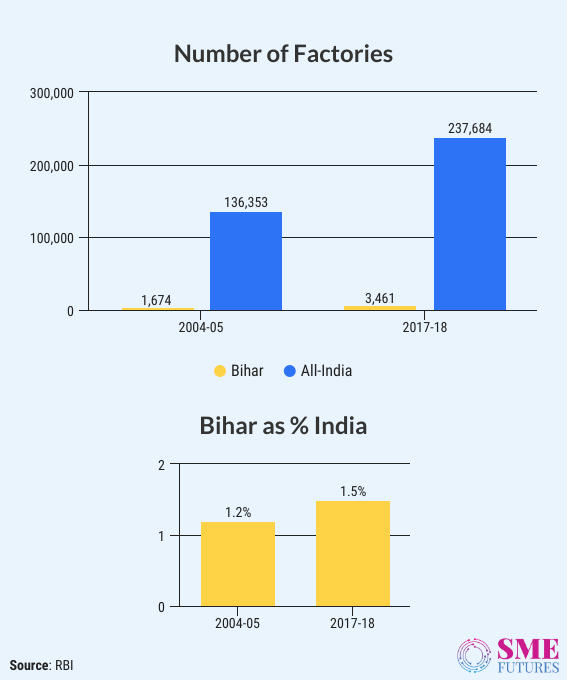
Again, this is fallout of the lower share of manufacturing in GSDP. Manufacturing has the potential of attracting higher investment which in turn generates more employment. The government hence needs to focus on providing the right incentives to empower it, suggests a CARE Ratings report. Adding to it, the low share of manufacturing also gets reflected in the low quantum of fixed capital in the state which is just 0.6 per cent of total.
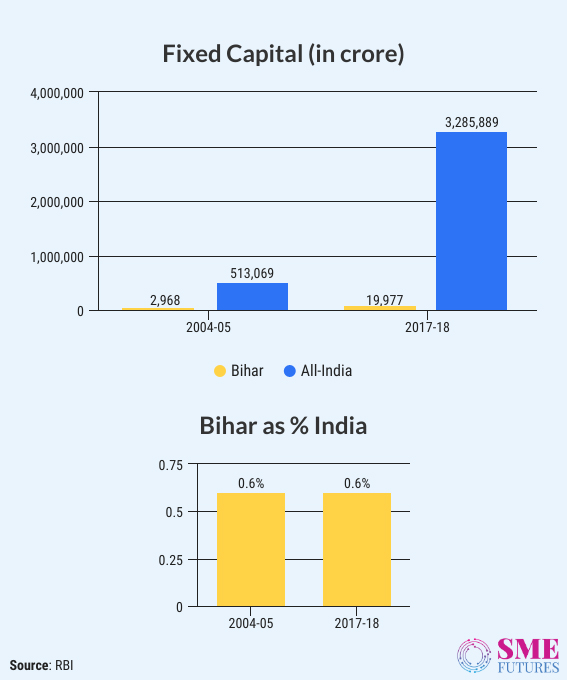
Current CM, Nitish Kumar once said in a statement in 2018 that Bihar lacks big industries due to its geographical location. He said that state is not able to set up big industries as it was landlocked and stressed on the need of encouraging small industries in such a situation. Associate Professor, Chirashree Das Gupta at JNU, in her essay wrote that bifurcation of the state is one of the reasons that industrialization has slipped off from Bihar.
“Bifurcation led to not only a decline of industry in Bihar, it also drastically altered the regional representation of different industries. Currently, food, tobacco, leather and non-metallic mineral products make up the base of present industry in Bihar. What has been lost is the industry based on coal, refined petroleum products, basic metals, motor vehicles and trailers, all of which were salient feature of the industrial map of erstwhile Bihar,” she writes.
Echoing the same thought, Prof. Pavnesh Kumar says, “Exactly, because the mines for raw material for industries like coal, zinc, iron etc are situated in Jharkhand. Moreover, 60 per cent of the GDP of Bihar comprises of service sector and only 23 per cent comes from industry. The major developed cities are now located in Jharkhand. So, demand of industrial product is less in Bihar as compared to Jharkhand.”
Besides geographical reasons, there are many other factors such as poor infrastructural and policies, scanty natural resources, and lack of skilled manpower which often explains lesser industrialisation in the region. But, most of the heavy industry after bifurcation of the state went to Jharkhand making agriculture overcrowded due to the dearth of employment opportunities.
On the other hand, Bihar as a state is way behind among other regions including Jharkhand, which bagged fifth position in ease of doing business ranking 2019. “Due to corruption, lack of infrastructure, lack of administrative reforms, law and order problems, and lack of political will has made setting of enterprises in Bihar a tough turf. Its rank is 26 out of 36 states and UTs (2019), and even the neighboring state Jharkhand is ahead of us,” exclaims Prof. Kumar.
Suggesting the future course of action, Dr Singh proclaims, “Bihar lags in the ranking for State Investment Potential Index (2018) and State Competitiveness Index (2017), amongst other rankings of Indian states. To make the state more competitive and investment friendly, the public investment in the transport sector in Bihar which has almost tripled from FY13 to FY20, needs to be enhanced. Currently, it is far below the national average in terms of length of national highways and railway tracks.”
Agriculture as a booster shot for economy
Bihar is a leading producer of vegetables, jute, and mesta. In addition to this, it is also known for Shahi litchi from Muzaffarpur, Zardalu mango from Bhagalpur, and Katarni rice. A table here shows how Bihar is progressing in contributing as an agrarian economy over past few years.
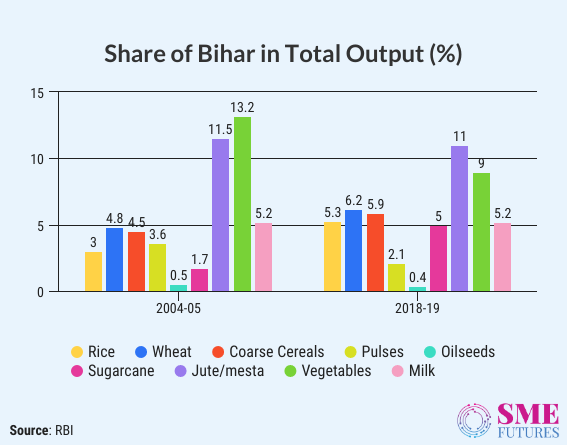
The table also indicates there is a lot of scope of improvement, as the share in total output is still lower when compared to the demographics. But, the fact that they have been increasing yield per hectare bears testimony to efforts they have put in. It also shows the natural advantage of fertile land of this region which are fed by rivers. Here is another table indicating a comparison with the national average.
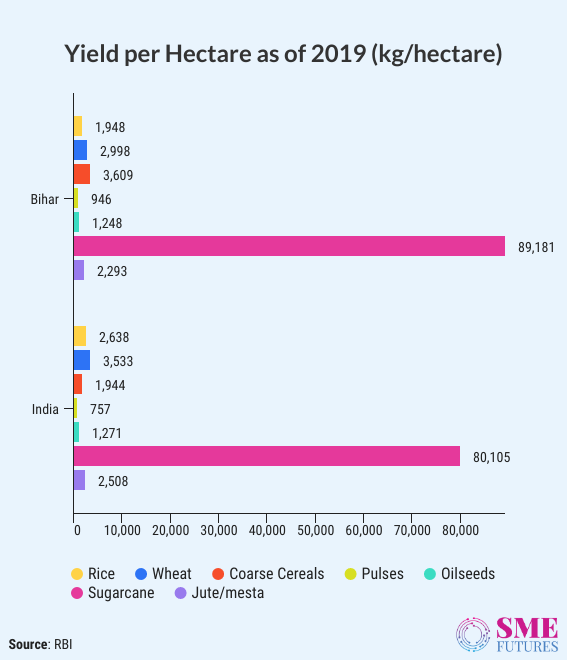
As per the analysis of CARE Ratings, productivity in Bihar is higher in coarse cereals, pulses, and sugarcane compared with all India average which is very encouraging. However, a lot of this has been achieved by very high use of fertilizers which is 70 per cent more than the national average. In case of Bihar, it is 227.3 kg per hectare against the national average of 133.1 kg per hectare in 2018-19.
Adding his views, Dr. Singh claims that agriculture sector can be game changer for the upheaval of Bihar economy. He claims, “We also believe that the agriculture reforms announced by the government will help farmers to access markets, realise better price for their products, encourage investments, and more importantly bring about standardisation in quality for exports. The agriculture sector of Bihar is likely to receive a boost through this.”
Measures boosting entities of manufacturing
The number of new projects announced has been on hike, which adds in the efforts to make a progressive Bihar. This in turn had put in more investments in the state. According to the data, it was 3 per cent of total in the country compared with 1.5 per cent 15 years back. Hence, it can be said that focus on manufacturing and development of more projects can lead to revival of the economy.
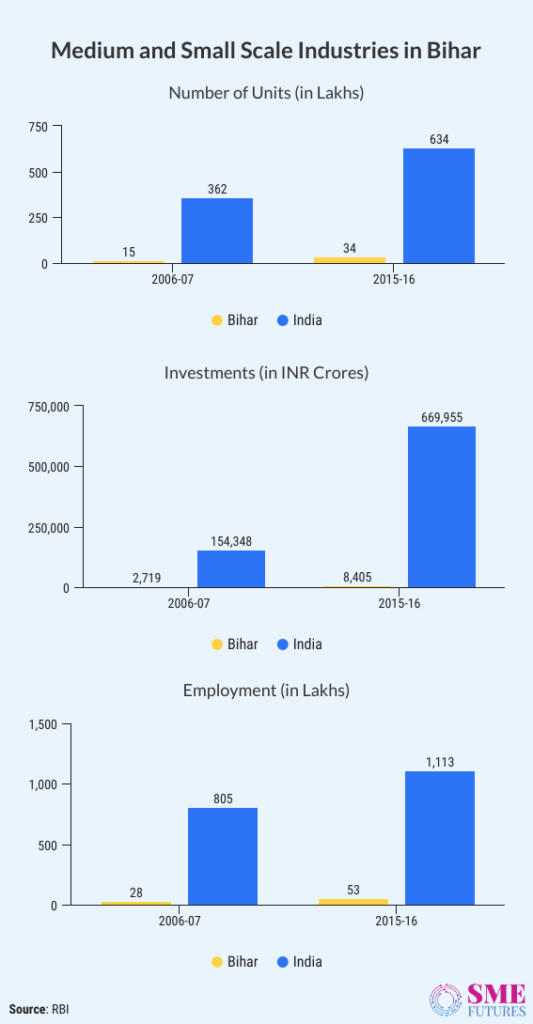
Overall Bihar stands at number 8th when it comes to medium and small-scale industries. Out of 5.4 per cent of the MSMEs, Bihar employs nearly 5 per cent of the total employed under this classification. However, the share of total investments under this classification is low at 1.3 per cent which saw a decline of 1.8 per cent in 2006-07.
Professor Kumar says that Bihar will be benefitted if the state focuses on manufacturing and setting up more micro units. According to him, the MSME sector will give some respite from the bigger issues related to unemployment. “As per the latest data there are 8.23 lakhs MSME units in Bihar. Out of which 8.05 lakhs are micro enterprises, 0.17 lakhs is small, and 0.16 lakhs is medium enterprises. It means major chunk in MSME sector is of micro-enterprises. This sector can hence become a growth engine of Bihar,” he suggests.
Along with manufacturing, the progress in infrastructure indicators such as power, roads and highways, railway tracks, and communication connections all show that there is a lot of scope for further improvement. Export is another sector that can add value to the economy. As Bihar is surrounded by land on all four sides, exports from the state have accounted for only 0.53 per cent of all-India exports in 2019-20. This share has marginally improved from 0.3 per cent in 2013-14, but there is still scope for improvement, states CARE Ratings.
Overall, a lot needs to be done to revitalise the economy of Bihar as it is one of the most populous states with lowest per capita income. Agriculture being one of its strength, the increased production can contribute in the fair shares of GSDP. It is currently higher than the national average. The state government also needs to improve rank in doing business to generate investments.
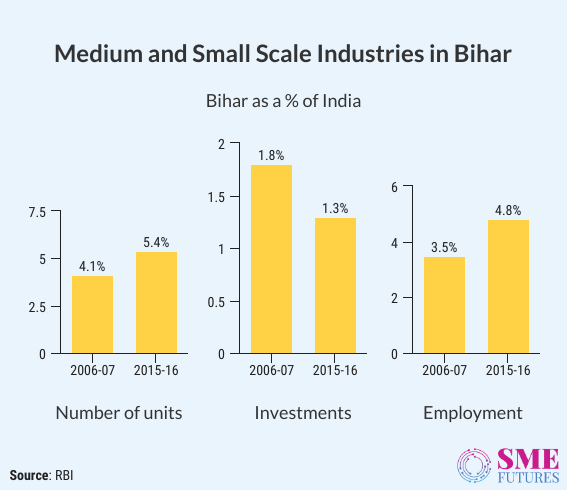
According to Prof. Kumar, information technology can become the game-changer for the currently ailing economy and it needs huge investment. The presence of large pool of educated and talented youth can be channelized for the development of Bihar. The second prominent sector is the food processing. Thirdly, leather industry as Bihar has enormous amount of livestock that serves as a huge raw material base may prove to be another important game changer in the revival of Bihar’s economy.











